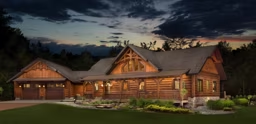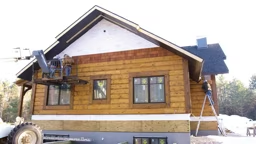 “You’ve got to spend money to make money.” It’s something you might hear a wheeler and dealer in Las Vegas say, but it’s usually not the first thing that comes to mind when you think about your log home. A number of new appliances, heating-and-cooling systems and plumbing fixtures are changing this notion, however. True to the adage, a hefty price tag often is involved. Once you start adding up the numbers, though, you’ll realize these items are worth the upfront cost because of the money you’ll save over time. Energy Star Appliances WHAT ARE THEY? Energy Star is a designation used by the Environmental Protection Agency for products that surpass the minimum federal requirements for energy and water efficiency. UPFRONT COST: Each Energy Star appliance is at least somewhat more expensive than a standard appliance. DOWN-THE-ROAD SAVINGS: Every Energy Star appliance will make back the extra money you spend on it with lower utility bills. (Timeframe for realizing these savings is anywhere from 5 to 15 years.) Geothermal Heat Pumps WHAT ARE THEY? In the simplest terms, geothermal heat pumps replace fuel-fed furnaces and air conditioners with an air-circulating pump buried deep in the ground. UPFRONT COST: “A geothermal system typically costs $3,000 to $7,000 more than a traditional system,” says Lisa McArthur of the International Ground Source Heat Pump Association (IGSHPA) at Oklahoma State University. DOWN-THE-ROAD SAVINGS: You’ll see a difference in your utility bill almost immediately. “Often, a homeowner will experience an immediate 50-percent reduction in their monthly cost,” Lisa says. Radiant Floor Heating WHAT IS IT? Radiant floor heating works by pumping hot water from your home’s water heater through a series of flexible tubes woven beneath the floor. The result is heat that warms you from toe to head. UPFRONT COST: “Prices range anywhere from $3 to $30 per square foot, depending on the complexity of the job,” says Don Dornbush, president of The FlorHeat Company in Okemos, Michigan. DOWN-THE-ROAD SAVINGS: “We’ve found that the operating costs for an in-floor radiant heating system will be 40 to 60 percent less than a typical forced-air heating system,” says John Dornbush, a sales engineer with FlorHeat. Energy-Efficient Windows WHAT ARE THEY? An energy-efficient window has two critical elements: double-pane glass and a Low-E coating. UPFRONT COST: “Low-E coatings will add approximately 10 to 15 percent to the cost of the window,” estimates Jay DeKalb, assistant product marketing manager for Jeld-Wen windows. DOWN-THE-ROAD SAVINGS: “A typical household can save between $125 and $340 per year by replacing single-pane windows with Energy Star-qualified models,” Jay says. High-End Log Finishes WHAT ARE THEY? “Recent advances in polymers, UV light inhibitors and mildewcides have significantly improved the look and performance of water-based coating systems,” according to Vince Palmere of Perma-Chink Systems. UPFRONT COST: The average cost of an oil-based stain is $37.50 per gallon, compared to $72.73 for a gallon of water-based finish. In other words, water-based finish is almost twice as expensive. DOWN-THE-ROAD SAVINGS: While a gallon of oil-based stain only covers 200 square feet, the same amount of a water-based finish covers 436 square feet. And when you consider that a water-based finish will last five years (compared to two years for oil-based stain), you can end up saving more than $10,000 with a water-based finish after 20 years. Tankless Water Heaters WHAT ARE THEY? Rather than pre-heating (and re-heating) the water and keeping it stored in a large tank, a tankless water heater uses a powerful heat source to heat the water as it flows through the unit. UPFRONT COST: Standard 30- to 80-gallon “tank” water heaters range in price from $300 to $1,000, and tankless heaters are priced from $500 to $1,100. DOWN-THE-ROAD SAVINGS: The savings offered by tankless heaters aren’t as remarkable as some of the other products in our survey. In a U.S. Department of Energy study, you can save up to $40 per year. (Sure, it’s a nominal number, but think of it as helping the Earth, too!) Low-Consumption Plumbing Fixtures WHAT ARE THEY? As the name implies, “low consumption” defines plumbing fixtures (toilets, faucets and showerheads) that consume less water than their competitors, which means lower utility bills. UPFRONT COST: The cost of a low-consumption toilet is comparable to the old models. In fact, all new toilets sold in the U.S. only can use 1.6 gallons of water per flush by law. DOWN-THE-ROAD SAVINGS: “On average, with an old 3.5-gallon-per-flush toilet, you’ll flush about 20 gallons per person, per day,” says Pete DeMarco, director of compliance engineering for American Standard. “This is reduced to only 8 gallons with low-consumption toilets, and 6.4 gallons with high-efficiency toilets.” Read the full story in the March 2005 issue of Log Home Living. |
Spend Big, Save Big: Smart Investments for Your Home1
Reeling from sticker shock over what that heating system or dishwasher is going to cost? Despair not! Some things you'll invest big bucks in now will save you money in the long term.







_11868_2023-06-20_11-49-256x288.avif)



